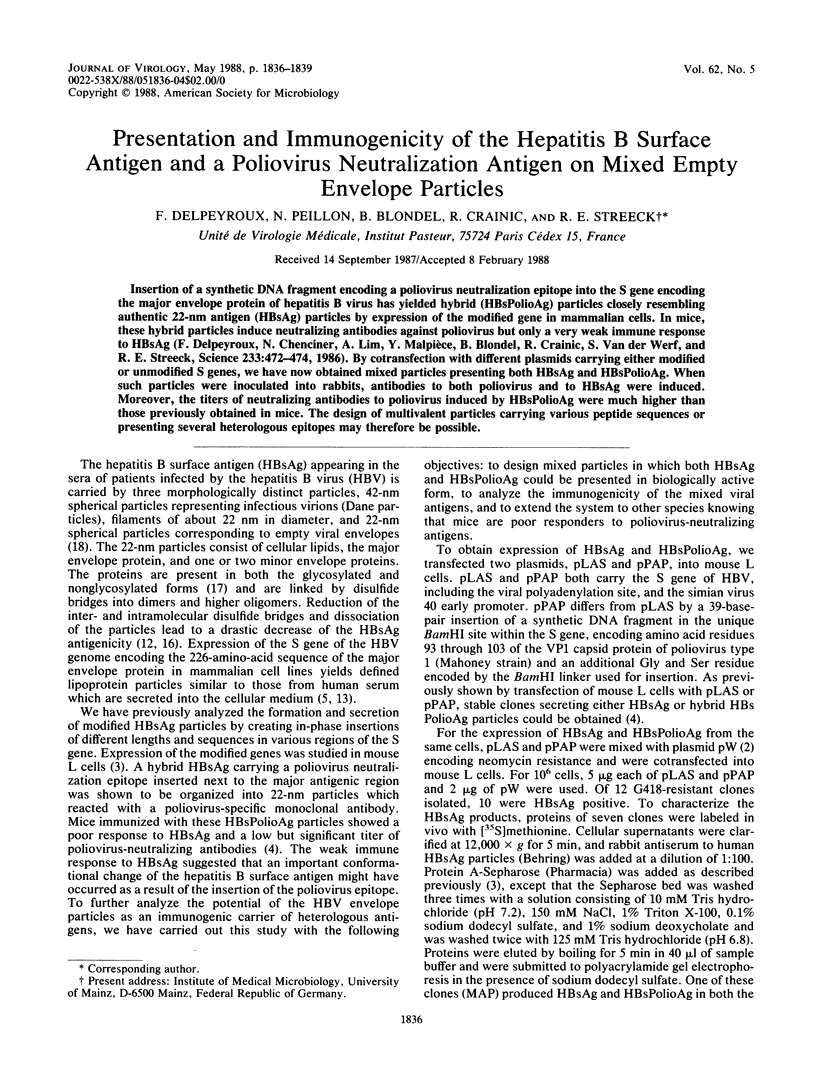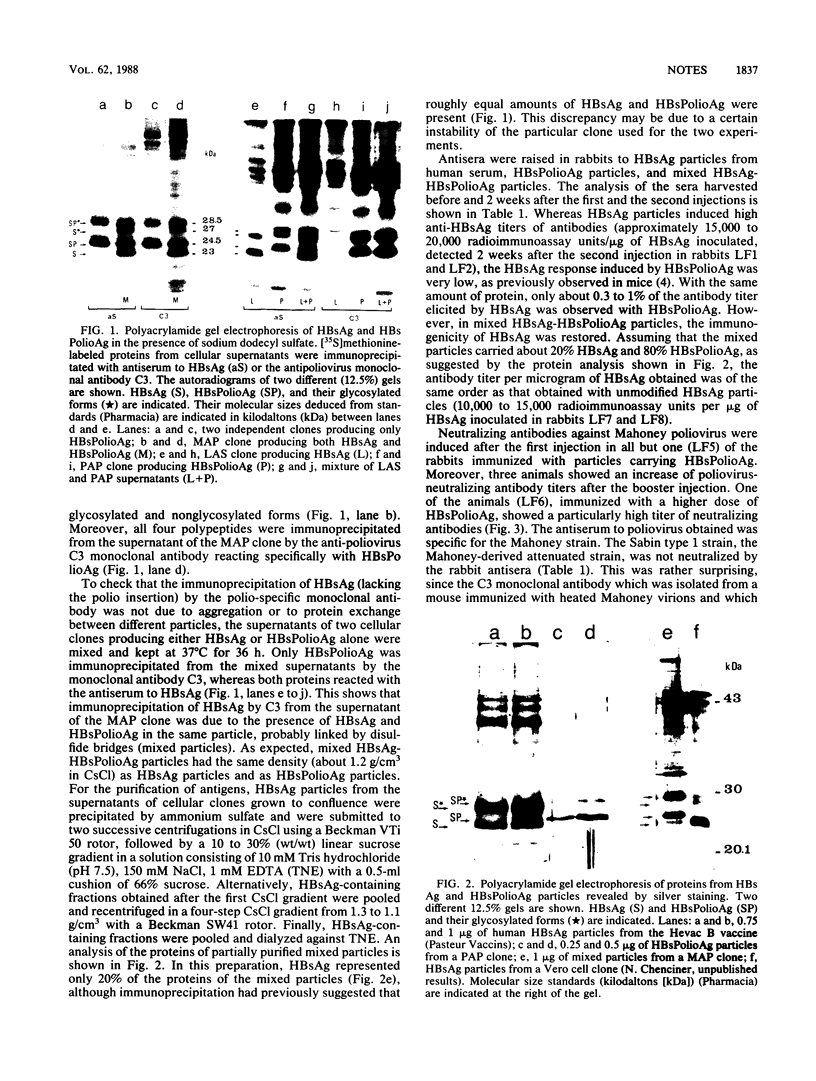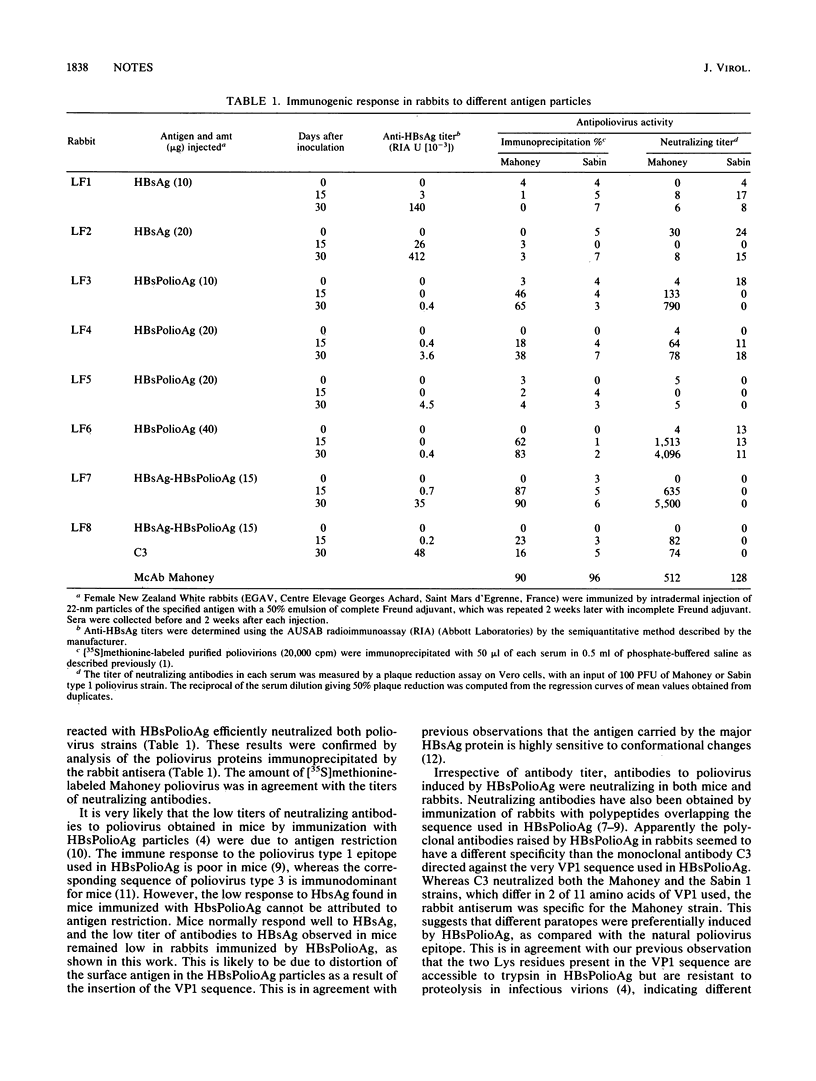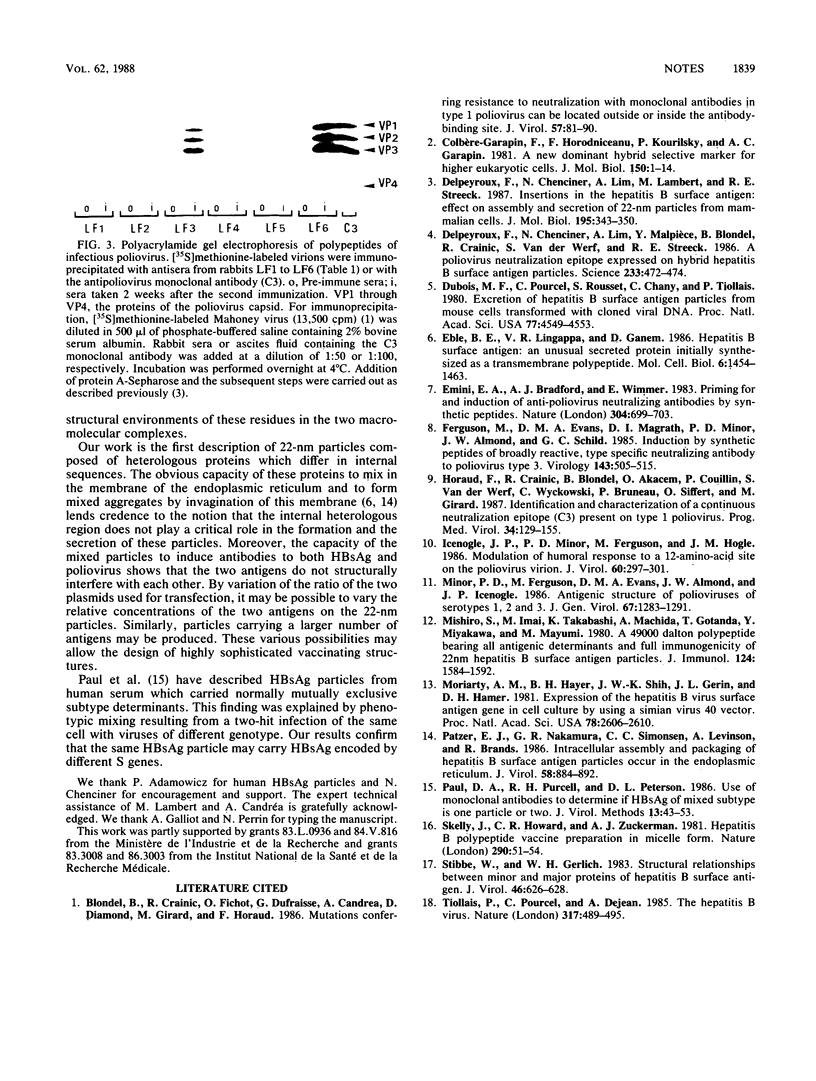Abstract
Insertion of a synthetic DNA fragment encoding a poliovirus neutralization epitope into the S gene encoding the major envelope protein of hepatitis B virus has yielded hybrid (HBsPolioAg) particles closely resembling authentic 22-nm antigen (HBsAg) particles by expression of the modified gene in mammalian cells. In mice, these hybrid particles induce neutralizing antibodies against poliovirus but only weak immune response to HBsAg (F. Delpeyroux, N. Chenciner, A. Lim, Y. Malpièce, B. Blondel, R. Crainic, S. Van der Werf, and R. E. Streeck, Science 233:472-474, 1986). By cotransfection with different plasmids carrying either modified or unmodified S genes, we have now obtained mixed particles presenting both HBsAg and HBsPolioAg. When such particles were inoculated into rabbits, antibodies to both poliovirus and to HBsAg were induced. Moreover, the titers of neutralizing antibodies to poliovirus induced by HBsPolioAg were much higher than those previously obtained in mice. The design of multivalent particles carrying various peptide sequences or presenting several heterologous epitopes may therefore be possible.
Full text
PDF



Images in this article
Selected References
These references are in PubMed. This may not be the complete list of references from this article.
- Blondel B., Crainic R., Fichot O., Dufraisse G., Candrea A., Diamond D., Girard M., Horaud F. Mutations conferring resistance to neutralization with monoclonal antibodies in type 1 poliovirus can be located outside or inside the antibody-binding site. J Virol. 1986 Jan;57(1):81–90. doi: 10.1128/jvi.57.1.81-90.1986. [DOI] [PMC free article] [PubMed] [Google Scholar]
- Colbère-Garapin F., Horodniceanu F., Kourilsky P., Garapin A. C. A new dominant hybrid selective marker for higher eukaryotic cells. J Mol Biol. 1981 Jul 25;150(1):1–14. doi: 10.1016/0022-2836(81)90321-1. [DOI] [PubMed] [Google Scholar]
- Delpeyroux F., Chenciner N., Lim A., Lambert M., Malpièce Y., Streeck R. E. Insertions in the hepatitis B surface antigen. Effect on assembly and secretion of 22-nm particles from mammalian cells. J Mol Biol. 1987 May 20;195(2):343–350. doi: 10.1016/0022-2836(87)90655-3. [DOI] [PubMed] [Google Scholar]
- Delpeyroux F., Chenciner N., Lim A., Malpièce Y., Blondel B., Crainic R., van der Werf S., Streeck R. E. A poliovirus neutralization epitope expressed on hybrid hepatitis B surface antigen particles. Science. 1986 Jul 25;233(4762):472–475. doi: 10.1126/science.2425433. [DOI] [PubMed] [Google Scholar]
- Dubois M. F., Pourcel C., Rousset S., Chany C., Tiollais P. Excretion of hepatitis B surface antigen particles from mouse cells transformed with cloned viral DNA. Proc Natl Acad Sci U S A. 1980 Aug;77(8):4549–4553. doi: 10.1073/pnas.77.8.4549. [DOI] [PMC free article] [PubMed] [Google Scholar]
- Eble B. E., Lingappa V. R., Ganem D. Hepatitis B surface antigen: an unusual secreted protein initially synthesized as a transmembrane polypeptide. Mol Cell Biol. 1986 May;6(5):1454–1463. doi: 10.1128/mcb.6.5.1454. [DOI] [PMC free article] [PubMed] [Google Scholar]
- Emini E. A., Jameson B. A., Wimmer E. Priming for and induction of anti-poliovirus neutralizing antibodies by synthetic peptides. Nature. 1983 Aug 25;304(5928):699–703. doi: 10.1038/304699a0. [DOI] [PubMed] [Google Scholar]
- Ferguson M., Evans D. M., Magrath D. I., Minor P. D., Almond J. W., Schild G. C. Induction by synthetic peptides of broadly reactive, type-specific neutralizing antibody to poliovirus type 3. Virology. 1985 Jun;143(2):505–515. doi: 10.1016/0042-6822(85)90389-7. [DOI] [PubMed] [Google Scholar]
- Horaud F., Crainic R., Van der Werf S., Blondel B., Wichowski C., Akacem O., Bruneau P., Couillin P., Siffert O., Girard M. Identification and characterization of a continuous neutralization epitope (C3) present on type 1 poliovirus. Prog Med Virol. 1987;34:129–155. [PubMed] [Google Scholar]
- Icenogle J. P., Minor P. D., Ferguson M., Hogle J. M. Modulation of humoral response to a 12-amino-acid site on the poliovirus virion. J Virol. 1986 Oct;60(1):297–301. doi: 10.1128/jvi.60.1.297-301.1986. [DOI] [PMC free article] [PubMed] [Google Scholar]
- Minor P. D., Ferguson M., Evans D. M., Almond J. W., Icenogle J. P. Antigenic structure of polioviruses of serotypes 1, 2 and 3. J Gen Virol. 1986 Jul;67(Pt 7):1283–1291. doi: 10.1099/0022-1317-67-7-1283. [DOI] [PubMed] [Google Scholar]
- Moriarty A. M., Hoyer B. H., Shih J. W., Gerin J. L., Hamer D. H. Expression of the hepatitis B virus surface antigen gene in cell culture by using a simian virus 40 vector. Proc Natl Acad Sci U S A. 1981 Apr;78(4):2606–2610. doi: 10.1073/pnas.78.4.2606. [DOI] [PMC free article] [PubMed] [Google Scholar]
- Patzer E. J., Nakamura G. R., Simonsen C. C., Levinson A. D., Brands R. Intracellular assembly and packaging of hepatitis B surface antigen particles occur in the endoplasmic reticulum. J Virol. 1986 Jun;58(3):884–892. doi: 10.1128/jvi.58.3.884-892.1986. [DOI] [PMC free article] [PubMed] [Google Scholar]
- Paul D. A., Purcell R. H., Peterson D. L. Use of monoclonal antibodies to determine if HBsAg of mixed subtype is one particle or two. J Virol Methods. 1986 Apr;13(1):43–53. doi: 10.1016/0166-0934(86)90071-6. [DOI] [PubMed] [Google Scholar]
- Skelly J., Howard C. R., Zuckerman A. J. Hepatitis B polypeptide vaccine preparation in micelle form. Nature. 1981 Mar 5;290(5801):51–54. doi: 10.1038/290051a0. [DOI] [PubMed] [Google Scholar]
- Stibbe W., Gerlich W. H. Structural relationships between minor and major proteins of hepatitis B surface antigen. J Virol. 1983 May;46(2):626–628. doi: 10.1128/jvi.46.2.626-628.1983. [DOI] [PMC free article] [PubMed] [Google Scholar]
- Tiollais P., Pourcel C., Dejean A. The hepatitis B virus. Nature. 1985 Oct 10;317(6037):489–495. doi: 10.1038/317489a0. [DOI] [PubMed] [Google Scholar]





